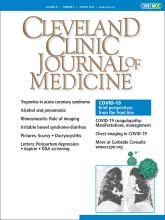The way we stratify risk for patients with chest pain suspected to arise from an acute coronary syndrome has rapidly evolved, thanks to higher cardiac troponin assay precision and sensitivity.1,2 Because fewer than 10% of patients in whom acute coronary syndrome is suspected actually have a myocardial infarction,3 algorithms using high-sensitivity assays have the potential to improve triage and reduce the costs associated with unnecessary hospital admissions and longer emergency department observation. The 2019 Fourth Universal Definition of Myocardial Infarction recommends using high-sensitivity cardiac troponin assays and has proposed criteria for further classifying patients with myocardial injury vs infarction.4
See related article, page 480
In this issue, Anderson and colleagues5 advocate against continuing to measure serial cardiac troponin levels after the diagnosis of acute coronary syndrome is established. Doing so lacks clinical utility and results in significant waste without improving patient care. We wholeheartedly agree with their plea.
The COMPASS-MI project (Calculation of Myocardial Infarction Risk Probabilities to Manage Patients With Suspicion of Myocardial Infarction)6 examined cardiovascular risk assessment based on cardiac troponin concentration, change in troponin level, and timing of resampling. Patients deemed to be at high risk based on their troponin level and absolute change during serial sampling had a significantly higher incidence of myocardial infarction and death. Of note, this determination was made using a 2-sample strategy, with the second sample obtained either early (45–120 minutes) or late (> 120–210 minutes) after the baseline sample.
THREE CLINICAL BUCKETS
Measuring cardiac troponin twice (at baseline and then either 1 hour or 3 hours later, using a high-sensitivity assay) enables clinicians to place most patients with chest pain into 1 of 3 clinical “buckets.”
Not acute coronary syndrome. Most patients fall into this category, having normal troponin levels, no increase in troponin level, and no other criteria for acute coronary syndrome. With the diagnosis ruled out, they can be safely discharged from the emergency department with minimal risk of acute ischemic complications or death. However, it is critical that other life-threatening causes of chest pain such as acute aortic dissection, pulmonary embolism, and pneumothorax be considered before this determination is made.
Definite acute coronary syndrome. At the other extreme, a minority of patients present with either established ST-elevation myocardial infarction on electrocardiography or marked elevations in troponin, which rules them in for significant acute myocardial injury. The higher the troponin level, the more likely ischemia or myocarditis is the cause of the chest pain, and admission would be warranted regardless of underlying mechanism.
Possible acute coronary syndrome. The challenge for a clinician is when troponin levels are in the intermediate range and the cause and nature of the elevation are uncertain. In particular, is the cause type 1 myocar dial infarction (due to arterial occlusion), or is it type 2 (due to supply-demand mismatch), and is it an acute or a chronic injury? And the optimal strategy for further evaluation is not well defined.
Sometimes trivialized with the terms “troponinemia” or “troponinitis,” troponin elevation that is not obviously associated with a diagnosis should not be dismissed as clinically irrelevant. To establish a diagnosis and determine further care, the clinical presentation and troponin findings must be integrated, and a judgment on the mechanism of myocardial injury must be made. However, further serial troponin testing is unlikely to benefit this group.
The High-STEACS trial (High-Sensitivity Troponin in the Evaluation of Patients With Suspected Acute Coronary Syndrome)7 assessed whether implementing high-sensitivity cardiac troponin testing and the recommendations of the Universal Definition of Myocardial Infarction led to changes in investigation, treatment, and outcomes in patients stratified according to the proposed diagnostic classification. The strategy led to increases in the diagnosis of type 1 myocardial infarction, type 2 myocardial infarction, and acute and chronic myocardial injury. Unfortunately, although the strategy “identified patients at high risk of cardiovascular and noncardiovascular events [it was] not associated with consistent increases in treatment or improved outcomes.”7 The investigators concluded by calling for trials of secondary prevention to determine whether this risk is modifiable in patients without type 1 myocardial infarction.
In conclusion, a 2-sample algorithm for high-sensitivity cardiac troponin testing is a powerful and rapidly evolving tool for determining risk of future cardiovascular events and all-cause mortality. It has introduced an important shift not only in understanding the degree and trend of troponin elevation, but also in acknowledging that any elevation is prognostically important regardless of the etiology. Dismissing troponin elevations as “troponinemia” no longer appears to be a viable strategy, and appropriate attention is needed to best assess cardiovascular and noncardiovascular risk.
- Copyright © 2020 The Cleveland Clinic Foundation. All Rights Reserved.






